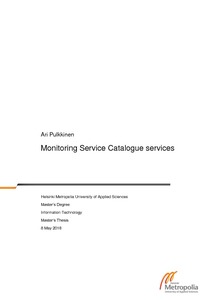Monitoring Service Catalogue Services
Pulkkinen, Ari-Petteri (2018)
Pulkkinen, Ari-Petteri
Metropolia Ammattikorkeakoulu
2018
All rights reserved
Julkaisun pysyvä osoite on
https://urn.fi/URN:NBN:fi:amk-201805087067
https://urn.fi/URN:NBN:fi:amk-201805087067
Tiivistelmä
The case company of the thesis was lacking a common service catalogue for its IT services. The company was already monitoring its infrastructure and some applications, but it was lacking service and more complex business process monitoring.
The target of the thesis was to evaluate and select the most suitable monitoring tool available and to implement monitoring service for the most business-critical services. A tool already in-house had to be used which limited the selection process only for a couple of tools.
First, a current state analysis of the existing monitoring tools in the case company was made. The current state analysis included interviews of the stakeholders and based on that information the requirements for the service monitoring tool was set. After that existing tools in the company were evaluated against the requirements and the most suitable tool was selected.
After the tool had been selected, the first services to be monitored needed to be decided. A list of the most business-critical services was received from the business unit representatives and four services were selected from the list where the service measurement creation did begun.
Finally, measurements for four most critical services were created. The outcome of the thesis; tangible measurements for the services along with the alert and report configurations using the most suitable tool available was demonstrated. Even though the tool had some limitations, it provided a good starting point and improved the monitoring capability greatly.
The target of the thesis was to evaluate and select the most suitable monitoring tool available and to implement monitoring service for the most business-critical services. A tool already in-house had to be used which limited the selection process only for a couple of tools.
First, a current state analysis of the existing monitoring tools in the case company was made. The current state analysis included interviews of the stakeholders and based on that information the requirements for the service monitoring tool was set. After that existing tools in the company were evaluated against the requirements and the most suitable tool was selected.
After the tool had been selected, the first services to be monitored needed to be decided. A list of the most business-critical services was received from the business unit representatives and four services were selected from the list where the service measurement creation did begun.
Finally, measurements for four most critical services were created. The outcome of the thesis; tangible measurements for the services along with the alert and report configurations using the most suitable tool available was demonstrated. Even though the tool had some limitations, it provided a good starting point and improved the monitoring capability greatly.
